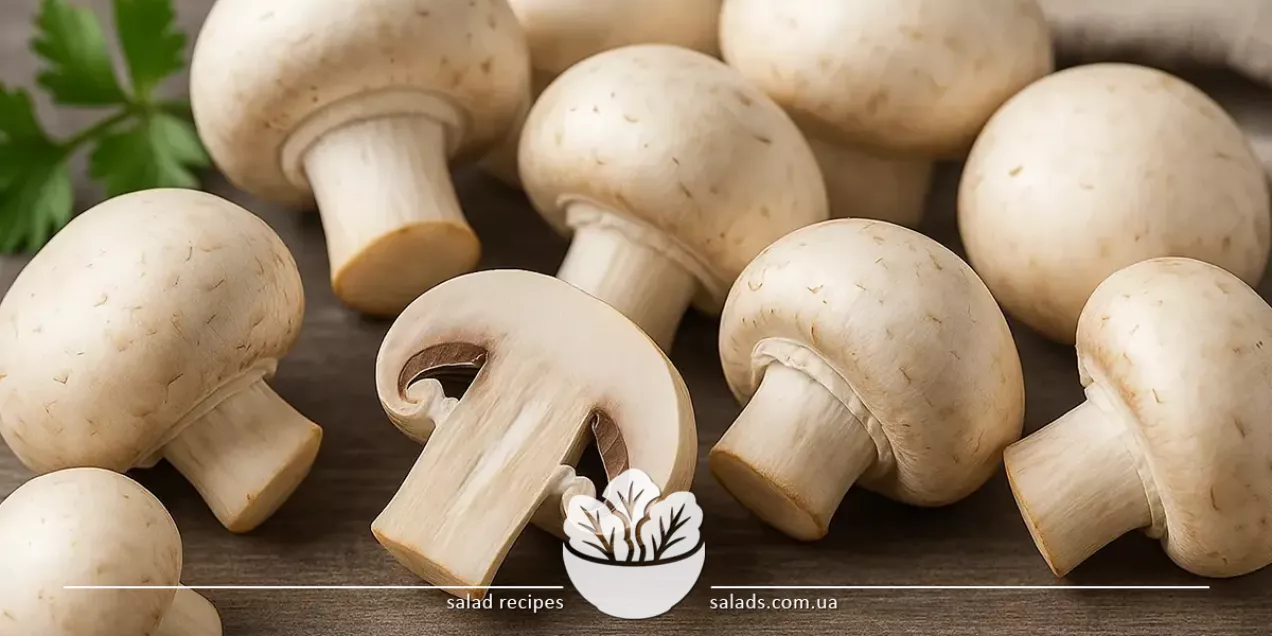
Champignons

Champignons are a universal ingredient widely used in everyday home cooking as well as in professional gastronomy. They are added to starters and main courses, used in salads, sauces, casseroles, pies, and side dishes. Their mild taste, quick cooking time, and ability to complement a wide range of other ingredients have secured their place in kitchens everywhere. They do not require pre-boiling, maintain a dense texture even after frying or baking, and are suitable for any type of heat treatment. You can learn more about other types of champignons in the dedicated section.
Salad Recipes with Champignons
Taste, Texture, and Versatility of Champignons
Fresh champignons have a delicate mushroom aroma and a mild, slightly nutty flavor that becomes more pronounced after cooking. Their texture is firm and springy, allowing them to keep their shape when fried, stewed, or baked. This makes them ideal for a wide range of dishes – from sides to mains, appetizers, and even cream soups. One of their key advantages is how quickly they cook – just a few minutes in a pan or oven, and they’re ready to serve. They absorb the flavors of other ingredients and spices well, creating rich, deep flavors in the final dish. This is why champignons are often used as the main component in vegetarian meals or as a flavorful complement to meat and vegetables. In everyday cooking, champignons are most often paired with yellow onions, which add a slightly sweet aroma when fried, enhance the mushroom base, and help develop a rich flavor profile. This pairing is one of the most traditional in mushroom fillings, casseroles, and sauces.
Heat Treatment: How to Cook Champignons Deliciously
Champignons are suitable for all types of heat treatment – they can be fried, stewed, baked, boiled, or grilled. Mushrooms quickly lose moisture in the pan, so they don’t need much oil for frying. To achieve a golden crust, it’s important not to overcrowd the pan – this ensures the mushrooms are sautéed rather than steamed in their own juices. In stews, champignons combine easily with vegetables, cream, sour cream, or tomato sauce. They absorb the flavors of seasonings, becoming tender yet keeping their structure. In the oven, they’re often cooked whole or stuffed – with cheese, eggs, herbs, or meat mixtures. For soups and casseroles, mushrooms are thinly sliced and pre-fried or boiled. In such dishes, champignons form the flavor base, especially when combined with ingredients like potatoes, which add heartiness, a creamy texture, and complement the mushroom aroma perfectly.
Champignons in Salads, Appetizers, and Cold Dishes
Fresh or marinated champignons are often used in salads, where they pair well with vegetables, eggs, herbs, and sauces based on sour cream, mayonnaise, or oil. They not only add flavor but also bring a textural contrast, especially when combined with crunchy vegetables or creamy dressings. In cold appetizers, champignons can be either one of the ingredients or the centerpiece – for example, as stuffed caps. In many classic salad recipes, champignons are combined with cooked vegetables, pickles, peas, corn, and seasonings. They contribute both taste and nutritional value, making the dish more satisfying without being heavy. They work especially well with mild or creamy ingredients, creating a balance between freshness and richness. In this context, chicken eggs are worth mentioning, as they are often used in salads with champignons. Their tender texture and neutral flavor let the mushrooms shine, enhancing the overall composition and bringing harmony to the dish.
Combining with Cheese and Other Ingredients for Baking
Champignons are one of the most popular ingredients for casseroles, pies, rolls, and baked dishes. They go perfectly with hard cheeses, cream, eggs, and bread bases, resulting in balanced and hearty meals. When baked, mushrooms remain juicy, gain a rich flavor, and develop an appetizing appearance. They’re often used as a filling for open and closed pies, tarts, and quiches – especially in combination with cheese. Grated cheese adds a creamy texture and forms a crispy golden crust during baking. These can be classic cheeses like cheddar, gouda, or maasdam, or local Ukrainian hard cheeses. Together with mushrooms, they form a vivid flavor profile suitable for both vegetarian and meat-based dishes. For example, a classic casserole with champignons and hard cheese is a simple yet impressive way to serve mushrooms as a main course. Additional ingredients can change the texture and taste of the dish, but the combination of mushrooms and cheese remains the core of many baked culinary creations.
Nutritional Value and Benefits in a Daily Diet
Champignons are not only tasty but also a healthy ingredient, rich in protein, dietary fiber, B vitamins (especially B2 and B3), and trace elements such as potassium, phosphorus, copper, and selenium. Their calorie content is low – about 20-27 kcal per 100 grams – making them ideal for dietary, vegetarian, and low-fat nutrition. Mushrooms contain amino acids similar in composition to animal proteins, which makes them particularly valuable in meat-free diets. Additionally, champignons are easy to digest, do not cause heaviness, and pair well with a wide variety of foods, allowing for the creation of balanced and nutritious meals. They can be served as a side dish, appetizer, or main course. In daily cooking, champignons are great for preparing quick and simple meals – omelets, sandwiches, salads, cream soups, stews – as well as more elaborate culinary creations. Thanks to their wide availability, low cost, and ease of preparation, champignons remain one of the most practical ingredients in modern cuisine.